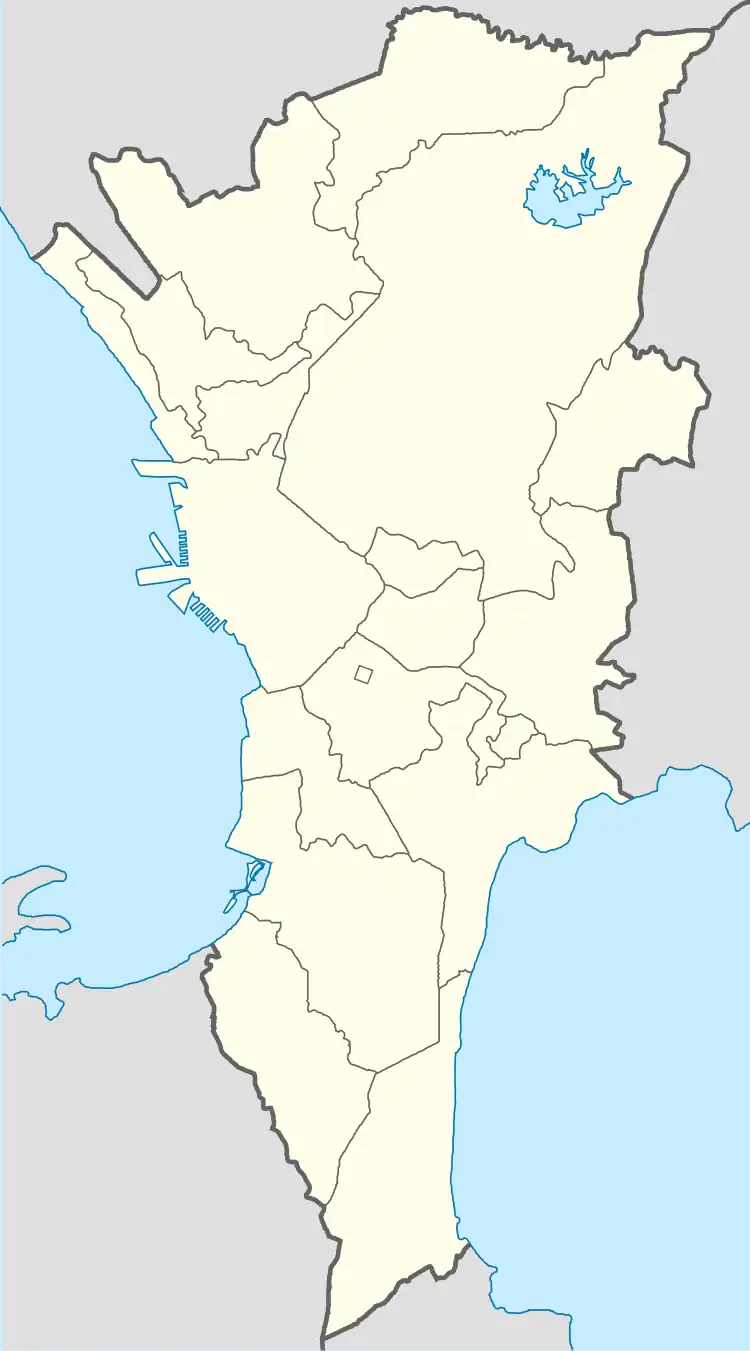Fort San Antonio Abad
Fort San Antonio Abad (Spanish: Fuerte de San Antonio Abad[2]), also known as Fort Malate or Fort San Antonio, is a fortification located in the Malate district of Manila, Philippines, completed in 1584 during the Spanish colonial period.
| Fort San Antonio Abad | |
|---|---|
| |
 | |
 Location in Metro Manila | |
| Former names | La Polvorista Fuerte de Polverina |
| Alternative names | Fort Malate Fort San Antonio |
| General information | |
| Status | Restored |
| Type | Fortification |
| Architectural style | Triangular bastioned fort |
| Location | Bangko Sentral ng Pilipinas (BSP) Complex |
| Address | Roxas Boulevard |
| Town or city | Manila |
| Country | Philippines |
| Coordinates | 14°33′45.5″N 120°59′12.6″E |
| Named for | Saint Anthony the Abbot |
| Completed | 1584 |
| Renovated | 1970s[1] |
| Owner | Government of the Philippines |
| Technical details | |
| Structural system | Masonry |
| Designations | Historical Structure marker from the National Historical Commission of the Philippines |
History
Named in honour of its patron saint, Saint Anthony the Abbot, the structure was originally built in 1584 in what was then a separate hamlet of Malate to serve as a rear protection for the Manila as well as to guard the Manila–Cavite route.
The Spanish used the fort as a polvorista ("little fortress") or gunpowder magazine.[3] The fort, known as Fuerte de Polverina, was captured by the British when they invaded Manila in 1762 during the Seven Years' War. They transformed the fort into a garrison from where the British forces launched their land offensive against the Spaniards defending Intramuros.[4] The fort was returned to Spanish control upon the end of the British occupation of Manila in 1764 and again became a gunpowder storage facility.[5]
The fort fell into American hands in 1898 during the Battle of Manila. During the Philippine–American War, U.S. military authorities used the prison to carry out multiple executions by hanging. The first American to be executed by U.S. authorities was Harry Cline, an American civilian under the employment of the United States Army.[6] On April 8, 1901, Cline rode out on a bicycle some 3 miles from Parañaque. He saw four small Filipino boys gathering grass. Cline, "with no other apparent motive than natural depravity", proceeded to shoot the boys with a revolver, wounding three and killing the fourth. The boy killed was Agaton Rivera. Cline was tried by an American military court, found guilty of murder and three counts of assault with intent to kill, and sentenced to death by hanging. He was executed on September 20, 1901.[7]
The fort was seized by occupying Imperial Japanese troops during World War II, when it was used as a bunker.
The fort suffered considerable damage after the war, but was not restored until the 1970s. The restored fort is now enclosed within the confines of the Bangko Sentral ng Pilipinas (BSP) Complex between the Manila Metropolitan Museum and other buildings.[1]
 Historical marker installed by the Historical Research and Markers Committee in 1937
Historical marker installed by the Historical Research and Markers Committee in 1937 Interior of Fort San Antonio Abad in the Bangko Sentral Complex
Interior of Fort San Antonio Abad in the Bangko Sentral Complex.jpg.webp) Aerial view of the fort during the American colonial period
Aerial view of the fort during the American colonial period
References
- "Fort San Antonio Abad – Manila". Muog: Spanish Colonial Fortifications in the Philippines. January 26, 2008. Retrieved April 24, 2012.
- Sonido, Juned (January 31, 2012). "The Other Fort: The Fort of San Antonio Abad". Baratillo Pamphlet. Retrieved April 24, 2012.
- Tracy, Nicholas (1995). Manila Ransomed: The British Assault on Manila in the Seven Years War. Exeter: University of Exeter Press. p. 34.
- Grant, James (1873). British Battles on Land and Sea. Vol. 2. London: Cassell, Petter & Galpin. pp. 126–130.
- Javellana, Rene (1997). Fortress of Empire: Spanish Colonial Fortifications of the Philippines. Makati: Bookmark.
- "Collapse, 1901 | Critics Rant". criticsrant.com. December 6, 2020. Retrieved August 20, 2023.
- Philippines, United States Congress Senate Committee on the (1902). Hearings Before the Committee on the Phillipines of the United States Senate in Relation to Affairs in the Philippine Islands [January 31-June 28, 1902]. U.S. Government Printing Office. pp. 2112–2113.